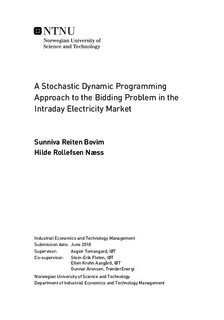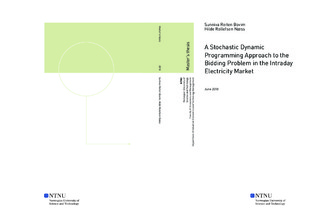| dc.description.abstract | The purpose of this thesis is to provide flexible market participants decision support in Elbas, in such a manner that they can take advantage of energy surpluses or deficits in the market after the spot clearing. A mathematical optimization model is constructed, integrating optimal scheduling and accurate market dynamics into a multisequential resource allocation problem. Variable production costs and unit commitment costs are included, while market prices are modelled as stochastic processes with the Markov property. The objective is to maximize expected profits in Elbas, determining the optimal timing and volumes of bids.
Stochastic Dynamic Programming (SDP) is utilized due to its strength in solving sequential decision problems. The continuous double auction in Elbas is modelled as discretized time steps, where new bids can be made at the beginning of each period. The real world problem consists of 24 hours of production, each regarded as individual products subject to trade in each time step of the auction. The horizon of the model corresponds to the time period where at least one product is available for trade in Elbas, namely 34 hours. The products have individual production commitments from the spot clearing, resulting in different remaining production capacities available for trade. Hence, the state space is given by 24 variable production capacities and 24 variable market prices. Discretizing of the state space results in a space size exponentially increasing with the number of products available for trade.
To handle the dimensional challenge of the state space, an approximated version of the problem is implemented applying aggregation of 6 products into a product block. The size of the state space is consequently reduced from $17\times10^{31}$ to $16\times10^4$. The discretized time steps in the auction are chosen to correspond to the length of a product block of 6 hours. The time period for trade extends over a longer time horizon than the time period of production, so the problem is implemented with 4 products subject to trade in 6 time steps. Optimal sequential decisions are found for the approximated problem by a backward recursion algorithm, evaluating the expected value of each decision. A time dependent policy for decision making is constructed, mapping all possible states of the approximated problem to a unique bidding decision in each time step. The policy is applied as a heuristic on the real world problem.
All parameters necessary to initialize the model are considered constant throughout the auction period, while market prices and remaining production capacities are variables described by the model state space. The model is run only once a day, even though stochastic, exogenous market prices arrive sequentially. During the day, the model collects the true market prices, and translates them into the corresponding state representation. All prices on the continuous time line can be understood and interpreted by the model - even spikes. At the arrival of new information, the policy serves as a contingency plan over the modelling horizon without further computations needed.
In order to evaluate the constructed model, both the value function and policy are investigated. To evaluate how well the model solves the real world problem, a procedure to find statistical upper and lower bounds of the optimal solution is presented. An adjustment heuristic to apply on the policy is found. This is to ensure a feasible lower bound to the maximization problem. To observe how policies respond to fluctuating market prices, policies for a number of days within selected test instances are constructed utilizing SDP.
The main finding from the policy analysis is that the SDP model finds incentives for arbitrage trading, before it stabilizes production volumes according to production costs and market prices before the close.
The opportunities for a market participant to increase profits by strategic bidding in Elbas, are increasing as the volumes and frequencies of trades increase. This development is expected to continue by the introduction of an integrated market with most of Europe (XBID). As the frequency of trades increases, quick reactions to the market is essential. Utilizing software as decision support for trading, serves as a first step to automatic trading. | |

